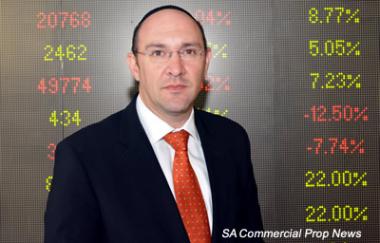Growth seekers advised to take long-term view on Property Stocks
 SA REIT Marketing Committee Chairman and CEO of Vukile Property Fund Laurence Rapp said It's important for investors to realise that there are many different outcomes for property returns, even as bond yields rise.
SA REIT Marketing Committee Chairman and CEO of Vukile Property Fund Laurence Rapp said It's important for investors to realise that there are many different outcomes for property returns, even as bond yields rise.
High volatility in SA's listed property sector over the past year has largely been blamed on rising bond yields, which conventional wisdom says is bad for property returns.
Despite recent results in the listed property sector either meeting or exceeding expectations, the performance of property stocks has been at the mercy of bond markets, which have generally been weak and volatile since mid-May.
The sector has continued its bumpy ride with the sector’s market capitalisation declining further since the major sell-off in May and early June.
In February, Bloomberg data showed the market capitalisation of the South African listed property index (FTSE-JSE Sapy index) declined 17.1% since its peak on about May 20. The decline represents almost R40bn being erased from the sector’s market capitalisation.
But more and more research shows that there is little empirical support for this thinking and that in some cases, rising bond yields and improving property returns can take place in parallel.
The SA REIT Association (SAREIT), a local umbrella body that works to promote REITs as an investment class, also strives to educate investors about the opportunities and challenges in the listed property sector.
"It's important for investors to realise that there are many different outcomes for property returns, even as bond yields rise," explains SA REIT Marketing Committee Chairman and CEO of Vukile Property Fund, Laurence Rapp.
Rising bond yields are just one of a host of factors that impact property returns. The South African listed property sector has outperformed all local asset classes for 11 of the past 13 years. With lower standard deviations in returns than general equities, it offers better returns over time, and through the cycle, with lower risk.
Rapp encourages investors to look at property as an asset class through the cycle and not to be too focused on short term volatility. “The defensive nature of property as an asset class is evident in its long term outperformance of equities and bonds,” say Rapp.
If higher inflation pushes bond yields up, property portfolios with inflation-linked leases could in fact benefit and the higher inflation is often driven by a buoyant economic environment that will be positive for commercial property.
"In SA, where property leases are typically signed with built-in net rental and operating cost escalations, this is a feasible scenario," he explains.
Recent research conducted by Towers Watson, a UK-based company that specializes in risk and capital management, found that little evidence exists to support the view that rising bond yields mean declining property returns.
Similar research undertaken in the US reached the same conclusion.
In the fact, the US research suggests that property investments in fact perform better in times of increasing interest rates - especially during periods of economic growth when property fundamentals are strong.
"Although research on this topic is limited, it underscores the need for investors and analysts to always assess a range of factors when considering property investments, listed or direct," he adds.
Ian Anderson, Chief Investment Officer of Grindrod Asset Manager notes that investors in South Africa typically only focus on the current yield of listed property relative to bonds and ignore the income growth component when valuing listed property. Or, they may apply a very low long-term growth rate to their income forecasts.
“This narrow focus is one of the reasons why listed property has outperformed the bond market by almost 15% a year over the last 10 years,” says Anderson. He notes listed property yields are too high relative to bond yields and the level of income growth produced. “In Grindrod Asset Management multi-asset portfolios we have a 25% allocation to listed property, the maximum allowed in terms of regulation 28, and virtually zero to South African bonds.”
















